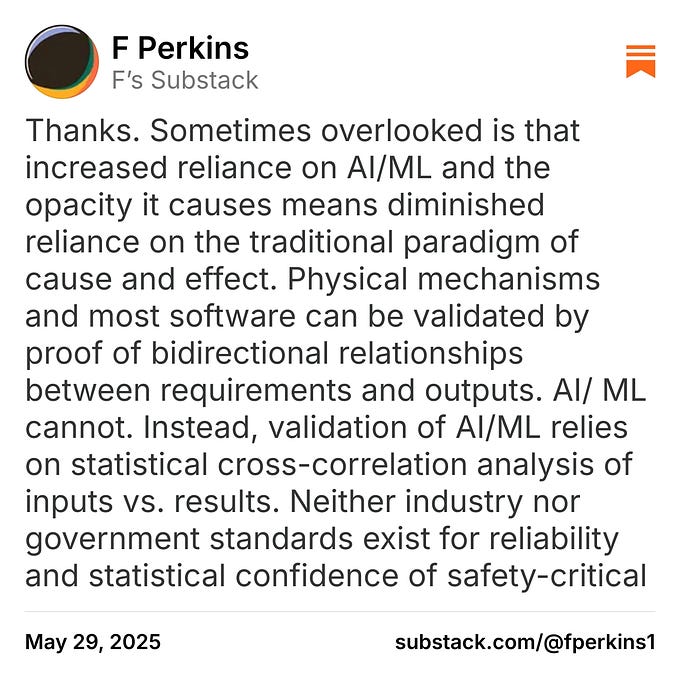philkoopman.substack.com/p/a-practical-list-of-embodied-ai-safety-497/comment/121218485
Preview meta tags from the philkoopman.substack.com website.
Linked Hostnames
3Thumbnail

Search Engine Appearance
F Perkins on Autonomous System Safety by Phil Koopman
Thanks. Sometimes overlooked is that increased reliance on AI/ML and the opacity it causes means diminished reliance on the traditional paradigm of cause and effect. Physical mechanisms and most software can be validated by proof of bidirectional relationships between requirements and outputs. AI/ ML cannot. Instead, validation of AI/ML relies on statistical cross-correlation analysis of inputs vs. results. Neither industry nor government standards exist for reliability and statistical confidence of safety-critical capabilities of AVs reliant on AI/ML technology. Extraordinary claims need extraordinary proof. Industry claims that abandoning reliance on the simple notion of ‘cause and effect’ for validation of safety-critical AV functions in favor of murky AI/ML aspirations is in the best interests of public safety. They have not.
Bing
F Perkins on Autonomous System Safety by Phil Koopman
Thanks. Sometimes overlooked is that increased reliance on AI/ML and the opacity it causes means diminished reliance on the traditional paradigm of cause and effect. Physical mechanisms and most software can be validated by proof of bidirectional relationships between requirements and outputs. AI/ ML cannot. Instead, validation of AI/ML relies on statistical cross-correlation analysis of inputs vs. results. Neither industry nor government standards exist for reliability and statistical confidence of safety-critical capabilities of AVs reliant on AI/ML technology. Extraordinary claims need extraordinary proof. Industry claims that abandoning reliance on the simple notion of ‘cause and effect’ for validation of safety-critical AV functions in favor of murky AI/ML aspirations is in the best interests of public safety. They have not.
DuckDuckGo
F Perkins on Autonomous System Safety by Phil Koopman
Thanks. Sometimes overlooked is that increased reliance on AI/ML and the opacity it causes means diminished reliance on the traditional paradigm of cause and effect. Physical mechanisms and most software can be validated by proof of bidirectional relationships between requirements and outputs. AI/ ML cannot. Instead, validation of AI/ML relies on statistical cross-correlation analysis of inputs vs. results. Neither industry nor government standards exist for reliability and statistical confidence of safety-critical capabilities of AVs reliant on AI/ML technology. Extraordinary claims need extraordinary proof. Industry claims that abandoning reliance on the simple notion of ‘cause and effect’ for validation of safety-critical AV functions in favor of murky AI/ML aspirations is in the best interests of public safety. They have not.
General Meta Tags
18- titleComments - A practical list of embodied AI safety concerns: Evading transparency (Part 2)
- title
- title
- title
- title
Open Graph Meta Tags
9- og:urlhttps://philkoopman.substack.com/p/a-practical-list-of-embodied-ai-safety-497/comment/121218485
- og:typearticle
- og:titleF Perkins on Autonomous System Safety by Phil Koopman
- og:descriptionThanks. Sometimes overlooked is that increased reliance on AI/ML and the opacity it causes means diminished reliance on the traditional paradigm of cause and effect. Physical mechanisms and most software can be validated by proof of bidirectional relationships between requirements and outputs. AI/ ML cannot. Instead, validation of AI/ML relies on statistical cross-correlation analysis of inputs vs. results. Neither industry nor government standards exist for reliability and statistical confidence of safety-critical capabilities of AVs reliant on AI/ML technology. Extraordinary claims need extraordinary proof. Industry claims that abandoning reliance on the simple notion of ‘cause and effect’ for validation of safety-critical AV functions in favor of murky AI/ML aspirations is in the best interests of public safety. They have not.
- og:imagehttps://substackcdn.com/image/fetch/w_680,h_680,c_limit,f_auto,q_auto:good,fl_progressive:steep/https%3A%2F%2Fsubstack.com%2Fnote%2Fc-121218485%2Fpreview.jpeg%3Fsize%3Dsm
Twitter Meta Tags
8- twitter:label1Likes
- twitter:data11
- twitter:label2Replies
- twitter:data21
- twitter:titleF Perkins on Autonomous System Safety by Phil Koopman
Link Tags
50- alternate/feed
- apple-touch-iconhttps://substackcdn.com/image/fetch/f_auto,q_auto:good,fl_progressive:steep/https%3A%2F%2Fsubstack-post-media.s3.amazonaws.com%2Fpublic%2Fimages%2Fac439826-cee4-488b-9bb1-7a163b31b78e%2Fapple-touch-icon-57x57.png
- apple-touch-iconhttps://substackcdn.com/image/fetch/f_auto,q_auto:good,fl_progressive:steep/https%3A%2F%2Fsubstack-post-media.s3.amazonaws.com%2Fpublic%2Fimages%2Fac439826-cee4-488b-9bb1-7a163b31b78e%2Fapple-touch-icon-60x60.png
- apple-touch-iconhttps://substackcdn.com/image/fetch/f_auto,q_auto:good,fl_progressive:steep/https%3A%2F%2Fsubstack-post-media.s3.amazonaws.com%2Fpublic%2Fimages%2Fac439826-cee4-488b-9bb1-7a163b31b78e%2Fapple-touch-icon-72x72.png
- apple-touch-iconhttps://substackcdn.com/image/fetch/f_auto,q_auto:good,fl_progressive:steep/https%3A%2F%2Fsubstack-post-media.s3.amazonaws.com%2Fpublic%2Fimages%2Fac439826-cee4-488b-9bb1-7a163b31b78e%2Fapple-touch-icon-76x76.png
Links
18- https://philkoopman.substack.com
- https://philkoopman.substack.com/p/a-practical-list-of-embodied-ai-safety-497/comment/121218485
- https://philkoopman.substack.com/p/a-practical-list-of-embodied-ai-safety-497/comment/121220097
- https://philkoopman.substack.com/p/a-practical-list-of-embodied-ai-safety-497/comments#comment-121218485
- https://substack.com